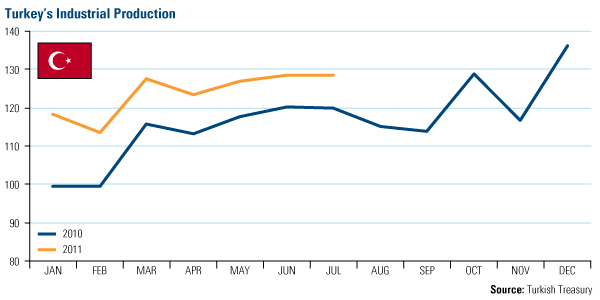As Western European countries grapple with anemic growth, Turkey’s second quarter GDP rose 8.8 percent.
Shares on the Istanbul Exchange sold off earlier this year on concerns of overheating, even after the economy grew 11 percent in the first quarter (recently revised to 11.7 percent), which outpaced China. Investors were concerned about high inflation and the rising disparity between the countries’ imports and exports. These, coupled with a deficit fueled in large part by the high price of crude oil imports, drove markets lower.
Many experts suggested Turkey increase interest rates to combat these inflationary fears. Instead, the Central Bank of Turkey (CBT) took the unorthodox move of cutting interest rates while at the same time raising overnight borrowing costs. The goal of this dual policy move was to slow down loan growth. Conversely, raising interest rates would have attracted even more carry trade.
When they were announced, the CBT’s unorthodox moves were splashed across headlines as unconventional and eccentric but the bank’s policies appear to have worked in the Turks’ favor. Because of a weakened Turkish lira and low interest rates, Turkey is now experiencing a tourism boom while also making exports more competitive in global trade. Data from Credit Suisse shows Turkey’s GDP expanded by almost 9 percent—2 percent greater than analyst estimates—during the second quarter.
Turkey’s industrial production, which is also highly sensitive to interest rates, has also increased recently. This chart from the Turkish Treasury illustrates the county’s first half industrial production growth compared to the same period in 2010. The country experienced a 6.7 percent year-over-year increase in industrial production in July, beating analyst expectations of a 4 percent year-over-year increase. (Read last week’s Investor Alert for more details.)

Interestingly the country’s growth in industrial production was largely driven by an increase in domestic demand, according to Credit Suisse.
Credit Suisse says the growth in industrial production is driven by increased domestic demand. Private investments in construction, retail trade, transportation and communication helped spur a 7 percent increase from the previous quarter, according to a report issued by Bahçeşehir University’s Center for Economic and Social Research.
Tim Steinle, who co-manages the U.S. Global Investors Eastern European Fund (EUROX), says the Turkish economy has posted uninterrupted sequential growth in GDP for the last nine quarters.
Tim thinks these are all signs that the CBT policies have worked. The country’s budget now sits at a surplus of $2.8 billion lira, partly reversing a deficit of $3.5 billion lira posted in July. As long as no “credit crunch” hits the global marketplace, Tim says it appears the Turks have successfully engineered a soft landing. Long term, we think low interest rates paired with the CBT’s banking policies will help the country meet, or exceed, analysts’ predictions of 6-7 percent GDP growth through the second half of the year.
- Bulenox: Get 45% to 91% OFF ... Use Discount Code: UNO
- Risk Our Money Not Yours | Get 50% to 90% OFF ... Use Discount Code: MMBVBKSM
Disclaimer: This page contains affiliate links. If you choose to make a purchase after clicking a link, we may receive a commission at no additional cost to you. Thank you for your support!



Leave a Reply